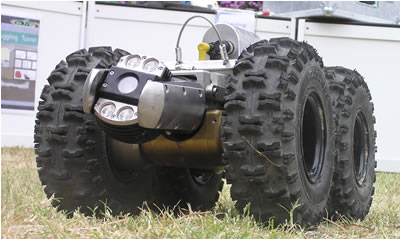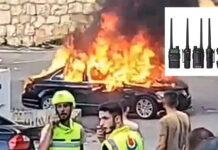The IDF has also been forced to take action to counter subterranean threats. Sophisticated seismic and acoustic equipment is employed to detect Palestinian tunnels, but the extensive system of tunnels, used for both smuggling and attack, left many tunnels undetected. Most tunnels began under existing buildings hidden from Israeli observation. Some led straight to the Egyptian border, and were used for transferring arms and smuggling of contraband. Others served as access routes to Israeli fortifications, which could then be destroyed by explosives. Realizing the potential threat of such tunnels, the IDF attempted to destroy tunnels by attacking them through ventilation ports with explosives. At least one such attack was made with a precision-guided JDAM bomb. To explore and map the tunnels, a new remotely controlled robotic vehicle is used by IDF combat tunnel warfare teams. The vehicle is lowered vertically into a tunnel, and moves independently inside, charting the internal passages, and sending video images back to the operators.

Rocket and Mortar Attacks
In 2003 and particularly 2004, the IDF repeatedly operated in the Gaza strip, primarily in pursuit of mortar and rocket launcher teams, and in search raids seeking to destroy weapons production facilities. While many raids proved successful, Rocket Artillery and mortar (RAM) attacks continued and even intensified, culminating in October 2004 in Operation Yemei Teshuva (Days of Atonement) when the IDF launched a massive two-week action to stop RAM attacks. The significance of this operation was in its method of implementation.
Extending the Brigades
The Givati brigade was given total responsibility for the operation, with direct command and control of all assets assigned to the operation. Many forces had already received advanced communications equipment, including remote video terminals, and hand held terminals, which enabled helicopter pilots and gunners, and commanders of lead infantry units to view real-time pictures as seen from UAVs and remote observation platforms. Tight integration with ISA operatives enabled rapid dissemination of intelligence information, at all levels, followed by immediate implementation of operational activities.
Tactics were also refined. Improved integration between armor, infantry and airborne forces enabled better coordinated activities, taking advantage of the dense urban area to achieve initial surprise, confuse the enemy and dominate the area for an extended period, without risk to the civilian population. Key to such operations was the brigade’s reconnaissance company, which was strengthened to battalion size and trained to execute rapid maneuvers deep inside the refugee camps’ narrow streets.
Additional parts of this article:
- Urban Combat – The Israeli Experience
- Israeli LIC Operations in Samaria
- Urban Combat Operations in Samaria (cont.)
- New Equipment for Urban Warfare fielded by the Israeli Army
- Israel, Palestinians Practice New Operational Concepts in Urban Warfare
- I.D.F Urban Warfare Battalion – Yata
- IDF Fields New C4 Equipment Optimized for urban Combat
- Israeli Army Tests New ISR Systems for Urban Warfare
- Israel Practice New Concepts for Airborne, Urban Area Domination



















